Grow & Care for Fuchsia Plant
Written by Iris
Oct 28 2021
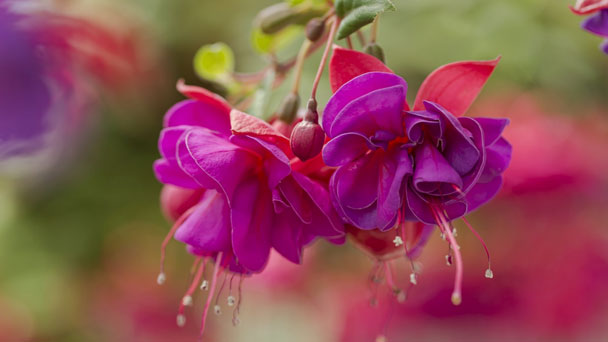
Fuchsia has a beautiful plant shape, wide leaves, emerald green, and a strange flower shape, which is very similar to a lantern. The flower color is more gorgeous, and it has a unique flavor when it sways gently with the breeze. But many flower lovers don't know much about how to grow and care for Fuchsia plants, so this article will introduce the tips in detail below.
Many fuchsia plants grow extremely well in pots. Fuchsias with a trailing habit are ideal for growing in hanging baskets or containers, and bush types can be trained as standards. You can buy ready-grown plants, or, if you’re patient, try it yourself – it can take a number of years. Remove the lower side shoots in spring and support the plant with a cane. If growing fuchsias plants in containers they’re often better with no underplanting as they’ll soon fill the pot.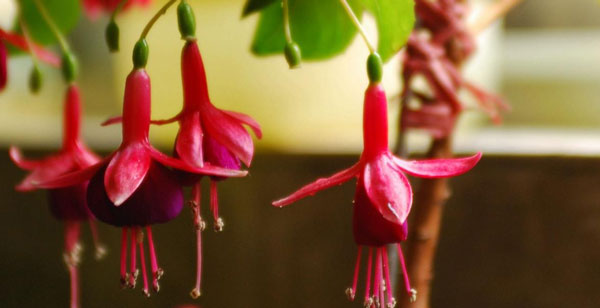
If you save seeds from a hybrid plant, keep in mind that they may not be viable, and will likely produce a plant with different characteristics from the parent plant if they do germinate.
Allow a few berries to form and mature until they're dark in color. Pick them, slice them open, scrape the seeds out, and plant immediately.
If you want to save the seeds, soak them in water for 30 minutes, and then rub the pulp off with a paper towel. Set them somewhere cool with good air circulation to dry.
When they are dry, store them in a cool, dark place in a jar or paper bag.
You can learn more about how to harvest and save fuchsia seeds in our guide.
To sow seeds, use six-cell seed trays filled with a light, porous seed starting mix. Make sure to clean your containers or use new ones, as well as fresh soil, to avoid damping off.
The seeds need light to germinate, so sprinkle them lightly on the soil and press them in place.
Moisten the soil and place the containers in a warm area that’s at least 65°F, near a window where they will get indirect light. Use a heating mat if necessary, as the ideal temperature for germination is 70-75°F. Keep the soil moist but not wet.
Then it's time to start a new gardening project, such as building some raised beds, while you wait one to four months for the seedlings to emerge. When each seedling has two true leaves, thin them out to one plant per cell.
When plants reach six inches tall, and all risk of frost has passed, harden them off over the course of about two weeks.
You can do this by bringing the tray outside to a protected location with indirect light for 30 minutes on the first day, and then bringing it back indoors. Add 30 minutes each day until it can stay outside all day long.
However, if the plant is over four feet tall and well-established, you risk damaging or even killing the parent plant because it is difficult to get enough of the roots out of the ground. Avoid dividing larger plants and try taking cuttings instead.
If you do decide to do this, plants should be divided either in the late fall after they have finished flowering, or early spring when they are still dormant, to limit stress. The plant should be pruned by a third before dividing (more details on pruning below).
Mature plants have an extensive root system, and you need to take care to dig as far out as the foliage was growing on the plant prior to pruning, and as deep as the plant was tall.
Dig up the entire plant, and use a spade to gently leverage the root ball out of the soil.
Gently shake and loosen the soil from around the roots. Use a pair of sharp clippers or a garden knife to cut the plant in half, roots and all.
Replant the original fuchsia, filling the hole back in with soil.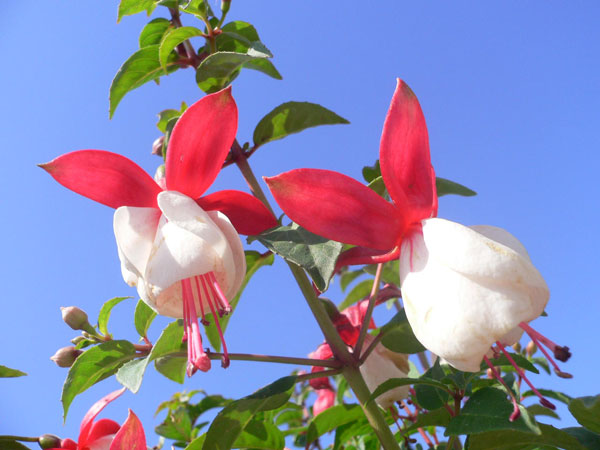
Fuchsia planted in gardens, once established, requires slightly less maintenance than potted Fuchsia. Garden Fuchsia should be planted in loose, well-drained soil. Plants will grow best if the soil is moist, but in a garden, they can tolerate a dry day better than potted plants.
Fuchsia should be regularly fertilized. Using a liquid fertilizer once every couple of weeks will allow Fuchsia plants to thrive and produce flowers throughout the growing season.
Fuchsias thrive in humidity, so if you live in a dry climate, you may have to mist your plants to keep them sufficiently moist. Keeping these plants happy indoors through the dry months of winter can be challenging because you'll need to run a humidifier to keep the space from becoming overly dry.
Climbing fuchsias: Prune out the oldest stems in spring when the fresh buds begin to break, and reduce the remaining stems to restrict their vigorous growth to the available space.
Rust is a cool weather disease and usually at its worst in the fall. Provide plants with a lot of room for air movement. Pick off affected leaves and destroy them, and avoid overhead watering, which favors spore germination. Give your plants more sun. Grow varieties that are less rust prone. Orange-flowered varieties tend to be the first to rust.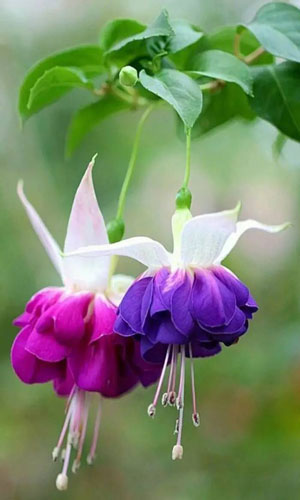
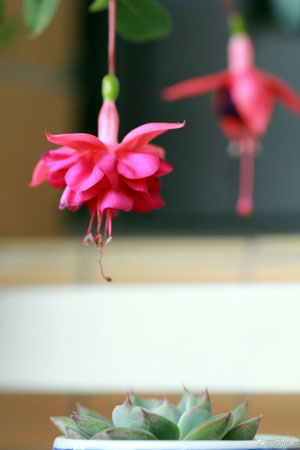
Tidy up the Fuchsia by removing all dead, dying, or damaged foliage and growth. This practice prevents disease from spreading in your plants. You can cut back the Fuchsia by half to keep it compact.
Pot the fuchsias in pots over the winter, with enough soil to accommodate the root ball. Send your fuchsias to a greenhouse or another well-lit structure.
Gardeners can also overwinter fuchsias in a garage or shed, provided that the plant becomes dormant and discards all of its leaves.
The standard Fuchsia requires overwintering in a frost-free place, due to the main stem being prone to damage from exposure to cold temperatures. This damage holds occurs even if the standard is a hardy variety.
You can keep hardy varieties of fuchsias in the garden over the wintertime. However, we recommend that you use some protection like a burlap to protect them from the frost or light snowfalls.
If overwintering in the garden, then make sure you add a thick layer of mulch to the soil and then top it with bark chips. Pack straw or burlap around the plant to insulate it from the cold weather.
Gardeners must make sure theta they don't cut back the stems until the springtime as new growth starts.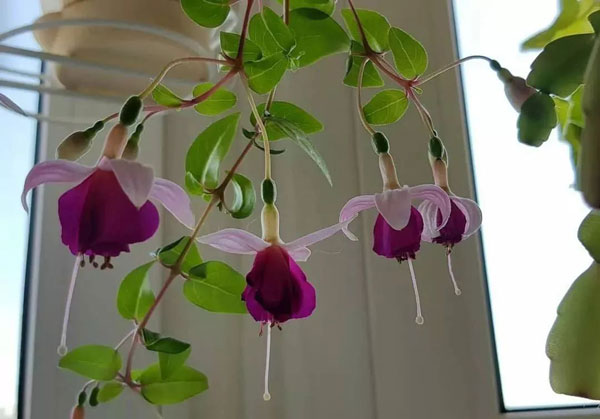
Read Next:
Top 10 Most Beautiful Roses in the World
Top 10 Most Beautiful Flowers in the World
26 Best Autumn Flowers to Plant for Fall Color in Garden
Where to Grow Fuchsia PlantHow to Grow FuchsiaGrow Fuchsia from SeedsGrow Fuchsia from Stem CuttingsGrow Fuchsia from DivisionHow to Care for Fuchsia PlantFuchsia Plant Light CareFuchsia Plant Soil CareFuchsia Plant Water CareFuchsia Plant Temperature & Humidity CareFuchsia Plant Fertilizer CareFuchsia Plant Pruning CareFuchsia Plant Pests & Diseases CareVarieties of Fuchsia PlantFuchsia Giant-Flowered Collection (Half Hardy)Fuchsia 'Shrimp Cocktail' (Hardy)Fuchsia 'Dollar Princess' (Hardy)Fuchsia 'Hawkshead' (Hardy)Tips for Overwintering FuchsiasFuchsia FAQAre Fuchsia Plants Annuals or Perennials?Are Fuchsia Plants Poisonous?
Where to Grow Fuchsia Plant
Plant fuchsias in sun or partial shade. A scorching, south-facing spot can be too much in the height of summer. Choose a sheltered spot, as the pendent flowers are easily blown off, especially on the larger flowering varieties. Fuchsias can cope with any type of soil, but it must be well-drained.Many fuchsia plants grow extremely well in pots. Fuchsias with a trailing habit are ideal for growing in hanging baskets or containers, and bush types can be trained as standards. You can buy ready-grown plants, or, if you’re patient, try it yourself – it can take a number of years. Remove the lower side shoots in spring and support the plant with a cane. If growing fuchsias plants in containers they’re often better with no underplanting as they’ll soon fill the pot.

How to Grow Fuchsia
Grow Fuchsia from Seeds
How to grow Fuchsia plant from seeds? First, you could purchase Fuchsia seeds, but you can also save some for replanting from a mature existing plant.If you save seeds from a hybrid plant, keep in mind that they may not be viable, and will likely produce a plant with different characteristics from the parent plant if they do germinate.
Allow a few berries to form and mature until they're dark in color. Pick them, slice them open, scrape the seeds out, and plant immediately.
If you want to save the seeds, soak them in water for 30 minutes, and then rub the pulp off with a paper towel. Set them somewhere cool with good air circulation to dry.
When they are dry, store them in a cool, dark place in a jar or paper bag.
You can learn more about how to harvest and save fuchsia seeds in our guide.
To sow seeds, use six-cell seed trays filled with a light, porous seed starting mix. Make sure to clean your containers or use new ones, as well as fresh soil, to avoid damping off.
The seeds need light to germinate, so sprinkle them lightly on the soil and press them in place.
Moisten the soil and place the containers in a warm area that’s at least 65°F, near a window where they will get indirect light. Use a heating mat if necessary, as the ideal temperature for germination is 70-75°F. Keep the soil moist but not wet.
Then it's time to start a new gardening project, such as building some raised beds, while you wait one to four months for the seedlings to emerge. When each seedling has two true leaves, thin them out to one plant per cell.
When plants reach six inches tall, and all risk of frost has passed, harden them off over the course of about two weeks.
You can do this by bringing the tray outside to a protected location with indirect light for 30 minutes on the first day, and then bringing it back indoors. Add 30 minutes each day until it can stay outside all day long.
Grow Fuchsia from Stem Cuttings
Fuchsia plants are easiest to propagate through stem cuttings taken in the spring.- Cut off a 2- to 4-inch segment of stem tip, making the cut just above the third pair of leaves.
- Remove the bottom leaves and dip the end of the cutting in rooting hormone.
- Plant the cutting into a tray or pot filled with a seed-starter mix or a blend of sand, perlite, and peat moss.
- Cover the pot with a loose clear plastic cover and place it in a warm location.
- Roots should develop in three to four weeks, and at this time you can remove the cover.
- When new leaf growth is obvious on the cutting, you can repot the fuchsia in a larger container and move it outdoors.
Grow Fuchsia from Division
Unless you are growing it as a single-stemmed standard, you can divide your fuchsia plant if it has outgrown its space, whether it’s growing in a container or in the ground.However, if the plant is over four feet tall and well-established, you risk damaging or even killing the parent plant because it is difficult to get enough of the roots out of the ground. Avoid dividing larger plants and try taking cuttings instead.
If you do decide to do this, plants should be divided either in the late fall after they have finished flowering, or early spring when they are still dormant, to limit stress. The plant should be pruned by a third before dividing (more details on pruning below).
Mature plants have an extensive root system, and you need to take care to dig as far out as the foliage was growing on the plant prior to pruning, and as deep as the plant was tall.
Dig up the entire plant, and use a spade to gently leverage the root ball out of the soil.
Gently shake and loosen the soil from around the roots. Use a pair of sharp clippers or a garden knife to cut the plant in half, roots and all.
Replant the original fuchsia, filling the hole back in with soil.

How to Care for Fuchsia Plant
Fuchsia Plant Light Care
Fuchsia plants do not grow well direct sunlight or excessive heat. For the best results, Fuchsia should be planted in areas that get partial sunlight. The temperature requirements may vary between varieties of Fuchsia, but as a general rule of thumb, Fuchsia plants grow best if the soil is cool and they are shielded from the hottest hours of sunlight. Plants that receive too much sunlight will lose their flowers quickly and wilt.Fuchsia Plant Soil Care
Fuchsia plants prefer consistently moist (but not soggy) soil with a good ratio of organic matter. At the same time, the soil should be well-draining. For in-ground plants, amending with peat moss or compost before planting is a good idea. Container plants do fine in an ordinary peat-based potting mix, provided the pot has good drainage.Fuchsia Plant Water Care
Fuchsia plants require moist soil to thrive. Fuchsia grown in containers should be planted in high quality, well-drained potting soil. Potted Fuchsia will likely require daily watering, but the best way to determine if they need watering is to stick a finger into the soil and make sure that it is damp. Potted Fuchsia will not thrive if the soil is left dry or if it is overly wet; if the soil is too wet, the roots may rot, killing the Fuchsia plant.Fuchsia planted in gardens, once established, requires slightly less maintenance than potted Fuchsia. Garden Fuchsia should be planted in loose, well-drained soil. Plants will grow best if the soil is moist, but in a garden, they can tolerate a dry day better than potted plants.
Fuchsia should be regularly fertilized. Using a liquid fertilizer once every couple of weeks will allow Fuchsia plants to thrive and produce flowers throughout the growing season.
Fuchsia Plant Temperature & Humidity Care
Fuchsias are happiest with temperatures between 55 and 80 degrees Fahrenheit, though some heat-tolerant cultivars will keep their blooms up to 90 degrees Fahrenheit. There are also a few shrub-like varieties that are hardy in freezing temperatures.Fuchsias thrive in humidity, so if you live in a dry climate, you may have to mist your plants to keep them sufficiently moist. Keeping these plants happy indoors through the dry months of winter can be challenging because you'll need to run a humidifier to keep the space from becoming overly dry.
Fuchsia Plant Fertilizer Care
During the blooming season, fuchsias have a huge appetite, so you have to feed them regularly with diluted liquid fertilizer. Many are available, and a combination of fish emulsion and seaweed can work well.Fuchsia Plant Pruning Care
Upright/bush fuchsias: Best pruned in spring, you should cut back the stems to a permanent low framework.Climbing fuchsias: Prune out the oldest stems in spring when the fresh buds begin to break, and reduce the remaining stems to restrict their vigorous growth to the available space.
Fuchsia Plant Pests & Diseases Care
In hot climates and for greenhouse growers, white fly can be extremely problematic. Whitefly populations in the early stages of population development can be held down by a vigilant program of removing infested leaves, vacuuming adults, or hosing down (syringing) with water sprays. Insecticidal soaps or oils such as neem oil may reduce but not eliminate populations. Don't miss the underside of the leaves. Test all sprays first; the tender leaves and flowers are easily burned. Also be aware of fuchsia gall mite, a microscopic mite that sucks the plant juices and injects a poison that causes the fuchsia to produce gnarled and crippled growth, similar to peach leaf curl. Stems, leaves, and flowers swell and become hairy and galled. Within these galls, the mites live and breed, protected from predators. See below for a detailed review of treatment.Rust is a cool weather disease and usually at its worst in the fall. Provide plants with a lot of room for air movement. Pick off affected leaves and destroy them, and avoid overhead watering, which favors spore germination. Give your plants more sun. Grow varieties that are less rust prone. Orange-flowered varieties tend to be the first to rust.

Varieties of Fuchsia Plant
Here is a list of some of our all time favourites:Fuchsia Giant-Flowered Collection (Half Hardy)
With big, frilly blooms, these colourful, trailing showstoppers come in a wonderful mix of colours. Ideal for baskets and window boxes.Fuchsia 'Shrimp Cocktail' (Hardy)
Resilient and hardy, this variety is a fusion of marbled hot pink petals with a candy blush; each bloom totally unique and almost luminous against the dark foliage. A truly exceptional plant when planted in borders and patio containers.Fuchsia 'Dollar Princess' (Hardy)
With an RHS AGM for its excellent garden performance, this bushy variety is popular for its profusion of double purple blooms with contrasting cerise pink sepals. A lovely compact specimen that works well in patio containers, wildlife gardens, or planted at the front of mixed borders.Fuchsia 'Hawkshead' (Hardy)
This beautiful hardy fuchsia boasts dark green leafy stems, hung with dainty white flowers that are suffused with a trace of green at the tip.
Tips for Overwintering Fuchsias
Gardeners must lift all trailing and half-hardy fuchsias from the flowerbed in the fall before temperatures start to fall below 41F. Overwinter your Fuchsia in a place in the garden that is free of frost.Tidy up the Fuchsia by removing all dead, dying, or damaged foliage and growth. This practice prevents disease from spreading in your plants. You can cut back the Fuchsia by half to keep it compact.
Pot the fuchsias in pots over the winter, with enough soil to accommodate the root ball. Send your fuchsias to a greenhouse or another well-lit structure.
Gardeners can also overwinter fuchsias in a garage or shed, provided that the plant becomes dormant and discards all of its leaves.
The standard Fuchsia requires overwintering in a frost-free place, due to the main stem being prone to damage from exposure to cold temperatures. This damage holds occurs even if the standard is a hardy variety.
You can keep hardy varieties of fuchsias in the garden over the wintertime. However, we recommend that you use some protection like a burlap to protect them from the frost or light snowfalls.
If overwintering in the garden, then make sure you add a thick layer of mulch to the soil and then top it with bark chips. Pack straw or burlap around the plant to insulate it from the cold weather.
Gardeners must make sure theta they don't cut back the stems until the springtime as new growth starts.

Fuchsia FAQ
Are Fuchsia Plants Annuals or Perennials?
Technically, fuchsia plants are perennials, but depending on the climate they may behave more like annuals. As tropical plants, fuchsias will only survive the winter in USDA hardiness zones 10-11. If you live in a colder climate and want to keep your fuchsia plant alive over the winter, bring it inside before the first frost. Encourage dormancy by placing your plant in a dark location where the temperature is around 50 degrees Fahrenheit, and only water once it once a month.Are Fuchsia Plants Poisonous?
No, fuchsia plants are not poisonous to humans or animals, making this a safe plant to have in your home if you have pets or small children. In fact, fuchsia flowers are edible and are often used as garnishes and decorations on cakes, pies, soups, and salads. If you wish to use your fuchsia flowers in your cooking, avoid spraying your plant with pesticides and herbicides to ensure that they remain non-toxic.Read Next:
Top 10 Most Beautiful Roses in the World
Top 10 Most Beautiful Flowers in the World
26 Best Autumn Flowers to Plant for Fall Color in Garden
Latest Updated
- Benefits of Bugleweed - 7 Science-backed Health Benefits
- Bugleweed Dangers & Side Effects - Is It Poisonous?
- How to Plant Evergreen Trees - What You Should Know
- When to Plant Evergreens - Grow Guide for Evergreen Trees
- 12 Wonderful Evergreen Shrubs for Your Garden
- 12 Popular Evergreen Plants with Pictures for Beginners
- When And How To Prune A Lilac Bush Like a Pro
- How to Grow & Care for Lilac Vine (Hardenbergia Violacea)
- Japanese Lilac Tree (Syringa Reticulata) Care & Propagation Guide
- Shumard Oak Pros and Cons - What to Know
Popular Articles
- Winter maintenance of Antirrhinum Majus
- How to Grow Terminalia Mantaly Tree
- How to Grow and Care for Crossostephium Chinense
- How to grow Antirrhinum Majus in spring
- Peristeria Elata (Dove Orchid) Profile: Info & Care Guide
- Underwatered Snake Plant (Sansevieria Trifasciata) - Signs And How To Fix
- How to Care for Brazilian Jasmine Plant (Mandevilla Sanderi)
- How to Grow & Care for Graptopetalum Purple Delight in Summer
- Rosa Chinensis (China Rose): Plant Growing & Care Tips
- How to Care for Baby Sun Rose (Aptenia Cordifolia)